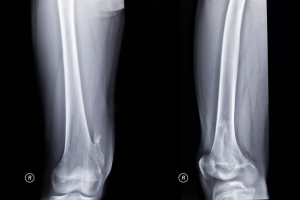Introduction
Langer Giedion Syndrome (also called “Trichorhinophalangeal syndrome, type II) is a genetic disorder where a small piece of the long arm of chromosome 8 is missing, which contains a number of regulatory genes important for normal development.
As a result there are characteristic facial features, small stature, a mild to moderate learning disability, skin, hair and bone abnormalities.
Signs and symptoms
These persons have a triangular shaped face , often there is a bulbar pear shape nose, sparse hair growth of the eye brows in the lateral aspect (on each side). There are deformed and laterally protruding (sideward projecting) earlobes. There are exostoses. Exostoses are extra bone and this occurs in ribs, the shoulder blade (scapula) and long bones. The hands are short and stubby, with deformed fingers and sometimes syndactyly. Speech development is delayed and mental retardation is common. There is conductive hearing loss. Joints are hyperextensible. There can be hormonal abnormalities such as idiopathic hypoglycemia, diabetes, hypothyroidism or growth hormone deficiency. There can also be urogenital abnormalities such as ureter bladder junction stenosis or reflux, heart abnormalities and renal defects. Hair growth is sparse and hair tends to be brittle and there can be extra skin folds. Typical findings on x-rays are the cone-shaped epiphyses of the fingers.
Diagnostic test
The micro-deletions can be identified with fluorescent probes specific for 8q24.1 (Langer Giedion syndrome). Short metacarpal bones are apparent on X-rays with cone-shaped epiphyses.
Treatment
As this is a genetic syndrome, there is no treatment for this. These individuals need to live in a supportive environment. They often end up in a home with staff who have a special interest in people with disabilities. There is also a requirement of special equipment to deal with these patients.
References
1. Goldman: Cecil Medicine, 23rd ed., Copyright © 2007 Saunders, An Imprint of Elsevier: Chromosomal Disorders
2. More information: https://rarediseases.org/rare-diseases/trichorhinophalangeal-syndrome-type-ii/







